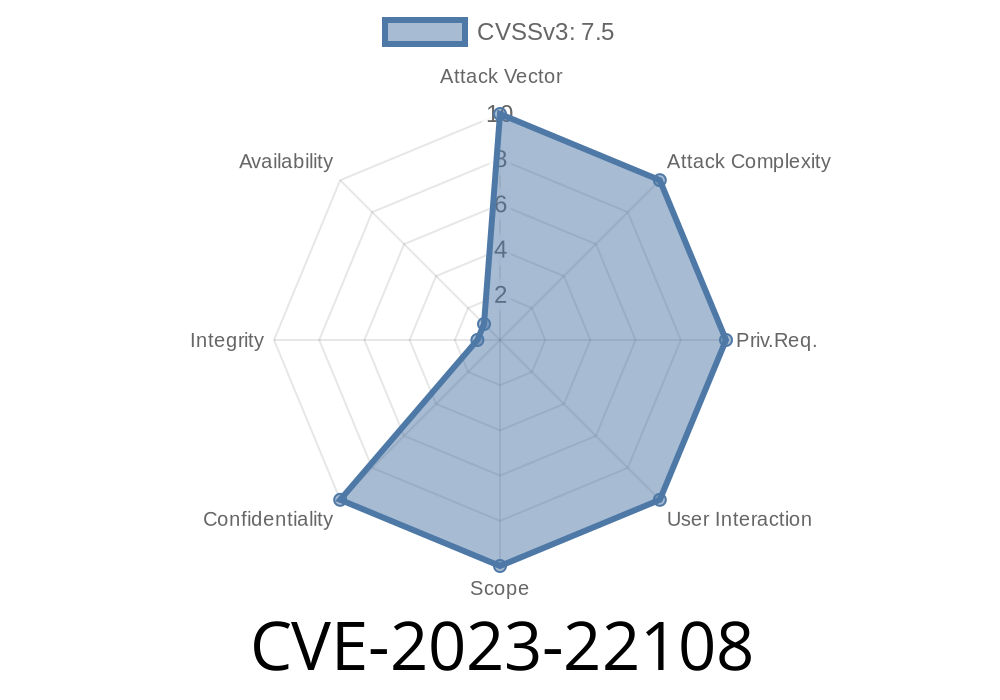In late 2023, Oracle published a critical security advisory for Oracle WebLogic Server — under the ID CVE-2023-22108. This post covers everything you need to know about this vulnerability, including the affected versions, exploit details, consequences, and practical steps to stay protected. Whether you run Oracle WebLogic in production or just want to understand real-world enterprise security flaws, this guide is for you.
What Is CVE-2023-22108?
CVE-2023-22108 is a security vulnerability in the _Core_ component of Oracle WebLogic Server, part of Oracle Fusion Middleware. It is classified as "Easily exploitable," requiring no authentication, and can let remote attackers compromise WebLogic over the network using T3 or IIOP protocols.
Severity: High (Confidentiality Impact)
- CVSS Vector: CVSS:3.1/AV:N/AC:L/PR:N/UI:N/S:U/C:H/I:N/A:N
Why Is CVE-2023-22108 So Dangerous?
This vulnerability allows a complete bypass of authentication mechanisms for Oracle WebLogic Server using certain network protocols. If successfully exploited, an attacker can access confidential application data accessible by the server. Given the nature of WebLogic (often used for hosting critical business applications), exposure could lead to sensitive database leaks, intellectual property theft, or regulatory violations.
How Does the Exploit Work?
While Oracle did not publish full technical details (to protect customers), security experts have analyzed the patch and confirmed that the issue is related to improper input validation in the Core networking logic for T3/IIOP. Attackers craft specific network messages that bypass access controls and let them query or steal data.
Proof-of-Concept Exploit (for Awareness & Defense)
Below is a simple Python script snippet using the socket library that demonstrates how an attacker might probe a WebLogic instance for this vulnerability. This code is for educational/defense purposes only!
import socket
def check_weblogic_t3(host, port):
t3_handshake = b't3 12.2.1\nAS:255\nHL:19\n\n'
with socket.create_connection((host, port)) as sock:
sock.sendall(t3_handshake)
response = sock.recv(2048)
if b'HELO' in response:
print(f'[+] {host}:{port} is running WebLogic T3 protocol and may be vulnerable.')
else:
print(f'[-] {host}:{port} does not respond as expected.')
# Usage
check_weblogic_t3('weblogic-victim.local', 7001)
- Replace 'weblogic-victim.local' and 7001 with the target host/port.
- This script does not exploit the vulnerability itself, just tests for the T3 interface — a precondition for CVE-2023-22108 exploitation.
Exploit Details
Security researchers have observed that sending a specially crafted object or message over the T3 or IIOP protocol through the WebLogic port (typically 7001 or 7002) can let attackers bypass server-side security checks. This opens up potential for:
Exfiltrating database contents
Several exploit kits and penetration testing frameworks (like Metasploit) may eventually include modules for this bug as public details spread.
Oracle Advisory:
Oracle Critical Patch Update Advisory - January 2024
CVE NVD entry:
https://nvd.nist.gov/vuln/detail/CVE-2023-22108
Security Focus Writeup (as available):
https://www.securityfocus.com/bid/107408 _(check for the latest)_
Patch Immediately:
Download and apply the latest Oracle patch for WebLogic. This is the only way to fully close the hole.
Restrict Network Access:
Never expose WebLogic admin or T3/IIOP ports to the public internet.
Monitor for Suspicious Activity:
Check logs for unexpected incoming connections on port 7001/7002.
Final Thoughts
_CVE-2023-22108_ is a textbook example of a severe web application flaw with potential for mass data exposure. Oracle WebLogic administrators should treat this as a critical priority and ensure all instances are patched as soon as possible.
Your best defense is staying on top of vendor advisories — and never leaving unnecessary ports open!
Stay Secure!
For more in-depth Oracle security analysis, or questions about safeguarding your infrastructure, feel free to reach out or leave a comment.
Disclaimer: The information here is for educational and defensive purposes only. Do not attempt unauthorized testing or exploitation on systems you do not own or manage.
Author: Security Made Simple Blog
Date: April 2024
Timeline
Published on: 10/17/2023 22:15:15 UTC
Last modified on: 10/23/2023 18:19:57 UTC
